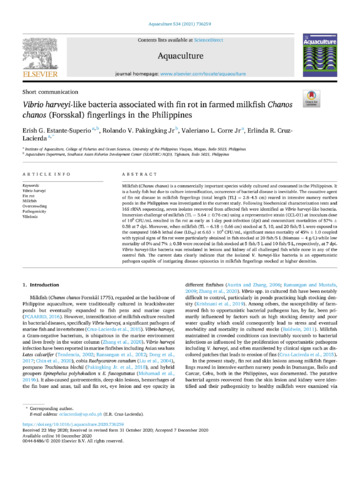Early development of fin-supports and fin-rays in the milkfish Chanos chanos
Share
စိတ္တဇ
Development of fin-supports and fin-rays was observed in larval and juvenileChanos chanos, Chondrification of the caudal complex started at 4.70 mm SL. Ossification of the caudal elements started at 7.80 mm SL and was nearly completed at about 30 mm SL. Cartilaginous fusion of caudal elements, which occurs in hypurals of higher teleostean fishes but is not seen in lower teleosts, was observed between the neural arch of the preural centrum 1 and that of the ural centrum 1 via a small cartilage bridging the distal tips of the two arches. Caudal finrays began to develop at 6.60 mm SL, and an adult complement of principal rays was attained at 7.35 mm SL. Dorsal and anal pterygiophore elements were first evident at 6.70 mm and 6.65 mm SL, respectively. All proximal radiais were formed at 8.15 mm SL in both fins. Formation of dorsal and anal fin-rays started simultaneously at 8.60 mm SL, and adult fin-ray complements were attained at 10,00 mm and 10.70 mm SL, respectively. In the pectoral fin, the cleithrum, coraco-scapular cartilage and blade-like cartilage (fin plate) had already been formed at 4.65 mm SL. The mesocoracoid was observed to originate from the coraco-scapular cartilage and become detached from it in the course of ossification. Pectoral fin-ray formation started at 13.80 mm SL and was completed in number of rays at 20.00 mm SL. In the pelvic fin, the basipterygium was first evident at 13.00 mm SL. Pelvic fin-rays appeared at 13.80 mm SL and attained their adult count at 17.15 mm SL.
ဖော်ပြချက်
Contribution No. 162 of the SEAFDEC Aquaculture Department.
Suggested Citation
Taki, Y., Kohno, H., & Hara, S. (1986). Early development of fin-supports and fin-rays in the milkfish Chanos chanos. Japanese Journal of Ichthyology , 32(4), 413-420. https://doi.org/10.1007/BF02905419
Taxonomic term
စုစည်းမှုများ စုစည်းမှုများ
- AQD Journal Articles [1249]
Related items
Showing items related by title, author, creator and subject.
-
Vibrio harveyi-like bacteria associated with fin rot in farmed milkfish Chanos chanos (Forsskal) fingerlings in the Philippines
Estante-Superio, Erish G.; Pakingking, Rolando V., Jr.; Corre, Valeriano L.; Cruz-Lacierda, Erlinda R. (Elsevier, 2021-03)Milkfish (Chanos chanos) is a commercially important species widely cultured and consumed in the Philippines. It is a hardy fish but due to culture intensification, occurrence of bacterial disease is inevitable. The causative ... -
Microscopic observation on dermal denticles of shark fins
Southeast Asian Fisheries Development Center (Secretariat, Southeast Asian Fisheries Development Center, 2006) -
Preliminary results of microscopic observation on dermal denticles of shark fins
Ali, Ahmad; Isa, Mahyam Mohd.; Zakaria, Noor Azman; Razak, Sollahuddin A.; Khiok, Annie Lim Pheik (Secretariat, Southeast Asian Fisheries Development Center, 2006)




